Career Moves: US Offshore Wind Powering Up
In addition to wind, offshore wind demands human energy, individuals with knowledge and skills first to build and then operate and maintain the dozens of projects required to meet President Biden’s 2030 goal of 30 GW of offshore generation. In an October 2022 National Renewable Energy Laboratory report – “U.S. Offshore Wind Workforce Assessment” – the authors estimate that it will require, on average, between 15,000 and 58,000 employees annually, depending on domestic content scenarios, to build out a huge new wind machine.
Mariners and mariner training are integral to offshore wind. The NREL Report lists 14 occupations directly performed aboard shipping vessels, tugboats and pilot boats. These range from the captain/master to head tunnelman to the boatswain/bosun to the pilot. Most jobs require a Coast Guard license or other certification.
Vessel operations, though, is just one work category. Another is the construction workforce, which NREL breaks into three subcategories:
The crew responsible for vessel specific activities and safety;
The project crew overseeing project management, quality control, and installation of specific packages (e.g., wind turbine, foundation, substation, or cable specialist crews); and,
The construction crew supporting installation (e.g., with activities like crane operations, welding, and so on).
Training demands are high, ranging from professional engineering licenses to Coast Guard licenses to certifications. Only a few jobs require just a high school diploma. Most entry-level roles require minimum certifications and training and some experience. Mid- and high-level roles, of course, present additional demands. Some roles, e.g., a heavy-lift vessel crane operator, or fallpipe technician may be vessel-specific, one person cannot be substituted for another.
[NOTE: This brief reference is just to at-sea occupations. Portside and land-based positions require additional workers with varying requirements. Critically, the NREL Report identifies 113 distinct roles, from finance and engineering to maritime and trades that will need to be considered in developing an OSW workforce.]
NREL spotlights five high-priority OSW occupations:
- Marine services technician - ensures completion of pre and postconstruction and wildlife and vegetation surveys. Requires a master’s degree or PhD.
- Permitting coordinator - a professional role supporting early-phase permitting, preconstruction, and construction. Requires a bachelor's degree in science, master’s or PhD preferred.
- Crane operator, portside and offshore - to install wind turbine equipment at heights greater than 270 feet. Specialized training required.
- Foundations package manager - develops, delivers and implements the planning and execution of the foundations package and may include managing contracts and safety and environmental issues. Requires a 4-year engineering degree.
- Offshore wind technician - manages, oversees, and conducts commissioning, testing, repair and maintenance of wind turbines and components. NREL references two existing training programs: Atlantic Cape Community College in New Jersey and Farmingdale State College in New York. A third is being developed at Rowan College of South Jersey.
In January, NYSERDA and the Offshore Wind Training Institute (OWTI) released a solicitation seeking “concept papers” to develop training “initiatives focused on addressing projected OSW workforce gaps and preparing workers for high growth jobs.” OWTI has $9 million available; awards would be between $500,000 and $3 million. Applicants’ cost share is 30%, but that drops to 10% for union-led projects and projects “exclusively serving Disadvantaged Communities and/or eligible Priority Populations.” Importantly, beyond this one program, NYSERDA has committed more than $170 million to support the creation of a clean energy workforce. OWTI’s total budget is $20 million.
A NYSERDA spokesperson said that so far, it has received nine concept papers. This has led to 12 full proposals for training and two contracts: to Hudson Valley Community College (HVCC) and LaGuardia Community College (LAGCC) for programs in welding and fabrication and construction, repair and maintenance of offshore wind facilities. This class is expected to graduate 125 people.
Farmingdale State College and Stony Brook University are also central to OWTI’s initiatives. On January 5, 2023, those colleges issued a joint solicitation for training programs. Proposals were due March 6, with awards ready on April 3.
John Nader is President at Farmingdale. He said the two institutions received 17 qualifying proposals. Nader said training awards will be announced May 1, about a month later than expected.
Regarding scale, OWTI’s goal is to train 2,500 people for OSW jobs through 2027.
Vineyard Wind’s 62 wind turbine project, 15 miles off the coast of Massachusetts, is ready to start construction. Vineyard Wind is hiring, or at least the contractors getting ready to build Vineyard Wind are hiring.
Dan Kent is operations coordinator for Vineyard Wind and was one of the principals in developing and hosting a career fair last January in New Bedford, Mass., a joint effort with the New Bedford Parks, Recreation & Beaches Department, and the New Bedford Ocean Cluster, a wind energy advocacy group. Thirty-seven companies participated.
Kent was asked about the career fair, whether it helped to move the needle, so to speak, regarding workforce development. And he was asked about the measures he uses for evaluation.
He called the fair a success, saying that “the number of people who signed in – between 400-500 people – is probably the biggest measure of success.” The number of potential employees in the hiring process is still being determined. Kent cited some optimistic anecdotal measures. Many companies, particularly maritime companies, he said, each had over 50 applicants. Kent himself collected 75 resumes.
“I haven’t spoken with every company yet,” Kent said, “but I’ve heard of 23 interviews being conducted and three hires, to three separate companies, made as a result of the job fair so far.”
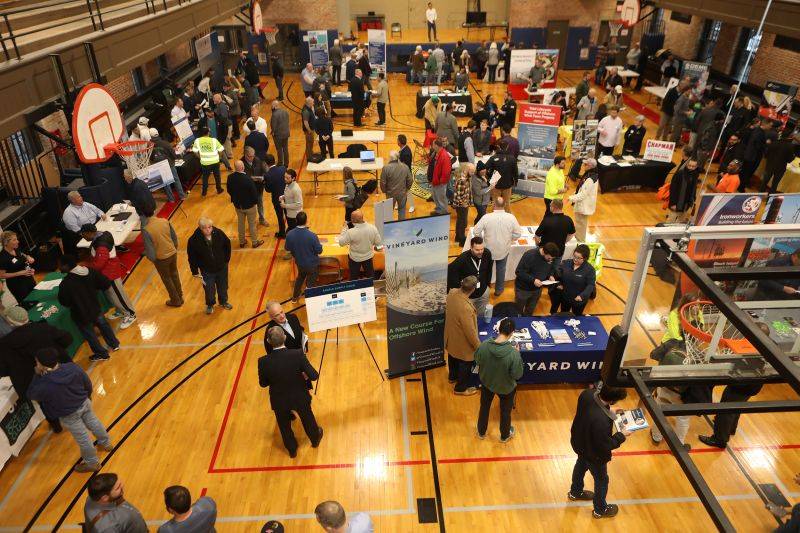 (Photo: Vineyard Wind)
(Photo: Vineyard Wind)
Kent was asked about skills needed by contractors vs. applicants’ skills, an alignment he referred to as a “mixed bag.” He noted “tons of alignment between mariner positions and the fishermen that attended”. But that match-up wasn’t as strong with construction positions, possibly, he said, because New Bedford “doesn’t have a huge union presence yet”. One company told Kent that about 50% of applicants were qualified but first needed to join a union. Demand and supply between attendees and science and marine biology openings was in good alignment “with the younger crowd,” Kent said, adding, “I’m sure SMAST (School for Marine Science & Technology, in New Bedford) being down the street helped a lot.”
Kent estimated that most applicants did not have wind experience, but that one-half had maritime experience and one-half had construction experience. He added, “That’s why we had training organizations attend as well.”
Kent said Vineyard Wind works closely with training organizations. The company has funded, via contractors, training for protected species observers. It has funded apprenticeship programs and works with the Business Network for Offshore Wind to assist smaller companies interested in wind energy opportunities. It created a program called the “Offshore Experience” to expose union members to life offshore. It has worked with the University of Massachusetts and Dartmouth on mariner training and licensing.
“We’ve been making a huge effort,” he commented, “to identify gaps in the workforce and then provide opportunities for solutions. We don’t want contractors to be able to say, ‘There weren’t any qualified, U.S. workers available so we had to bring in (our workforce).’”
Kent was asked if workforce development has expanded to the scale needed by Vineyard Wind. He said no, not yet. For example, he said that a dearth of programs for HUET – helicopter underwater escape training – has created a bottleneck. For Vineyard, the closest HUET facility is in Groton, Conn., and Kent said, “They’re packed full pretty much through the summer.” New employees may need to travel to the Gulf region for HUET. Bristol Community College in Massachusetts is developing a HUET program, but it will start too late, Kent said, for Vineyard’s construction. HUET is required for employees transferred via helicopters to their worksite, but not required for those carried via crew transfer vessels.
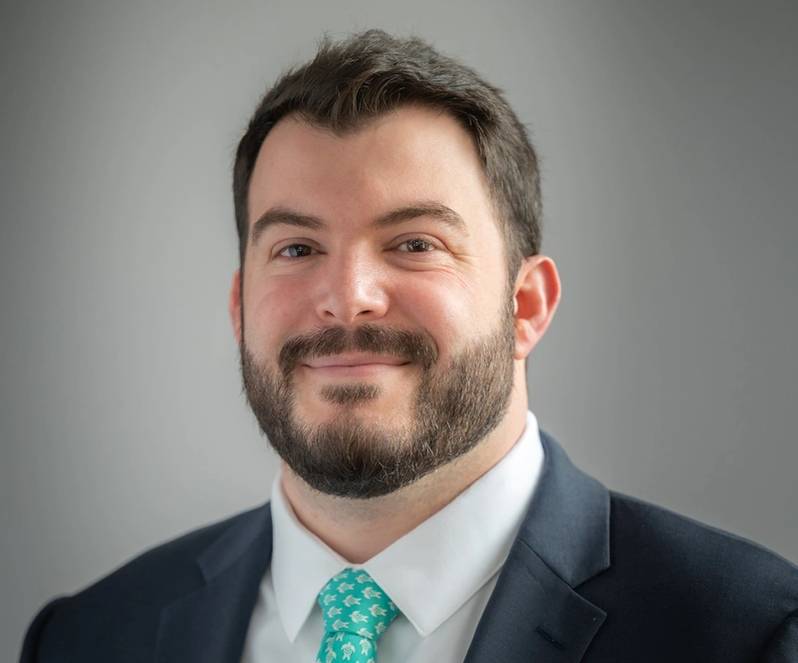 “We’ve been making a huge effort to identify gaps in the workforce and then provide opportunities for solutions. We don’t want contractors to be able to say, ‘There weren’t any qualified, U.S. workers available so we had to bring in (our workforce).’” - Dan Kent, operations coordinator, Vineyard Wind (Photo: Vineyard Wind)
“We’ve been making a huge effort to identify gaps in the workforce and then provide opportunities for solutions. We don’t want contractors to be able to say, ‘There weren’t any qualified, U.S. workers available so we had to bring in (our workforce).’” - Dan Kent, operations coordinator, Vineyard Wind (Photo: Vineyard Wind)
Capt. Gerard C. Pannell is director of training for the STAR Center (Simulation, Training, Assessment and Research), a division of the Safety & Education Plan of American Maritime Officers (AMO), the largest maritime labor organization for licensed merchant mariners in the U.S. The STAR facility is in Dania Beach, Fla.
Pannell was asked about developing a training curriculum, whether companies request specific courses or whether training organizations offer more general courses likely to provide in-demand skills. He said that STAR works with operators and partner companies. In most cases, he explained, the operator will provide a detailed training matrix that is used as the basis for course development.
Pannell said that STAR is focused on crews that operate vessels for offshore wind projects. One area of closer focus is dynamic positioning (DP) training and operations including “walk-to-work” (motion compensated gangway operations) and cable laying. Pannell emphasized, though, “that the STAR Center and AMO are just beginning to undertake the training needed for employment in the U.S. offshore wind sector. We continue to enhance and expand our capabilities and curriculum to meet these needs.”
Pannell was asked about scale, about how many students/applicants can be accepted in STAR programs. He said the STAR Center issues more than 4,000 course certificates to more than 2,000 individuals each year. However, statistics for students in wind training are not available. He added, “Only a very small percentage of our current throughput would be for those who are looking to entering the wind sector.”
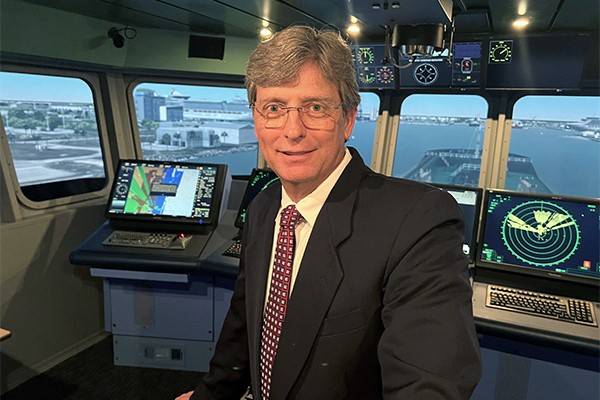 “The STAR Center and AMO are just beginning to undertake the training needed for employment in the U.S. offshore wind sector. We continue to enhance and expand our capabilities and curriculum to meet these needs.” - Capt. Gerard C. Pannell, director of training, STAR Center (Photo: STAR Center)
“The STAR Center and AMO are just beginning to undertake the training needed for employment in the U.S. offshore wind sector. We continue to enhance and expand our capabilities and curriculum to meet these needs.” - Capt. Gerard C. Pannell, director of training, STAR Center (Photo: STAR Center)
Finally, regarding social equity questions Pannell said that STAR’s TECH Apprentice Engineer Program, within the last 18 months, had its first female and first person of color apprentices complete the program and earn Coast Guard credentials.
Klaus Luhta is assistant director of business development for MITAGS – Maritime Institute of Technology and Graduate Studies. In response to similar questions Luhta said MITAGS works with operators to create simulated navigation environments. He said that the Global Wind Organization (GWO) has developed a basic training suite of courses for personnel working on and around wind turbines. MITAGS recently received audit approval to start certain GWO training, which will start soon, Luhta said.
Regarding scale up, Luhta said MITAGS, with advanced notice, “has virtually unlimited capacity to scale for the industry’s demands. Currently our GWO classes can accommodate 50-60 students per week with ability to expand as needed.”
Regarding diversity, and whether separate initiatives are necessary to build a diverse workforce, Luhta commented, “The current offshore wind industry is represented by a wide range of Americans, and we expect the student body to be the same once students begin training regularly.”
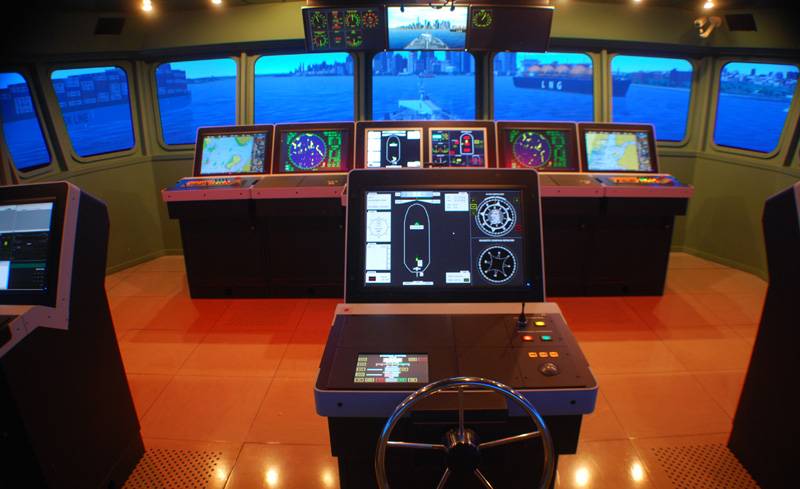 STAR Center is a not-for-profit division of the Safety & Education Plan of American Maritime Officers, the largest maritime labor organization for licensed merchant mariners in the U.S. (Photo: STAR Center)
STAR Center is a not-for-profit division of the Safety & Education Plan of American Maritime Officers, the largest maritime labor organization for licensed merchant mariners in the U.S. (Photo: STAR Center)
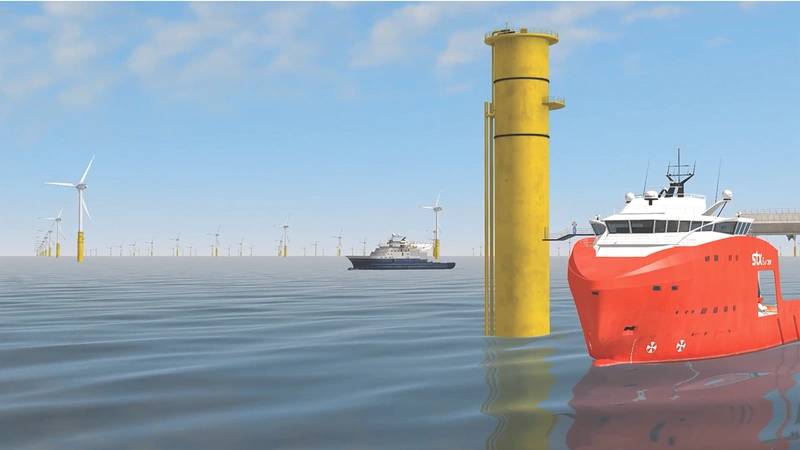 (Image: STAR Center)
(Image: STAR Center)
NREL’s Workforce Assessment Report
As noted in the main report NREL’s “U.S. Offshore Wind Workforce Assessment Report” was published last fall, October 2022.
The report is a deep dive into workforce issues, both at-sea and within ports and staging areas. It also addresses manufacturing and supply chain issues.
The report makes a series of recommendations – “Key Actions to Bridge Supply and Demands.” NREL suggests alignment between state and regional providers and industry requirements. Safety is a concern – the report states that “currently there is no official industry training standard,” although coordination is moving forward. It suggests that U.S. and global entities collaborate to structure training and leverage lessons from international offshore wind projects while also providing U.S.-specific context. The authors write that “based on discussions with stakeholders, general awareness of the types and breadth of workforce roles required is low.”
NREL was asked about industry-education follow up since the report’s release. Jeremy Stefek is a workforce and economic development researcher at NREL. He said people have called the report a great resource, useful to develop funding applications and program expansions.
Stefek said NREL shared the report’s findings at the Offshore Wind Workforce Summit, hosted in partnership with the Business Network for Offshore Wind at the International Partnering Forum (IPF) on March 28. The audience – about 250 people – included state officials as well as representatives from universities, community colleges, training providers and labor unions.
Stefek was asked about some of the top issues for training providers. He listed four:
- More coordination between industry and training programs;
- Reducing barriers to increase participation of underrepresented groups by providing more wrap-around services;
- Standardization of training requirements and roles; and,
- Making people aware of job opportunities, especially with K-12 populations.
Importantly, the NREL team is now focusing on safety standards and training for work carried out at-sea, both construction and operations, which he said is one of the critical workforce gaps in the report. He said NREL is interviewing people now “to better understand the challenges and hear their proposed solutions. We will share our additional findings in a published resource in the next few months.”




